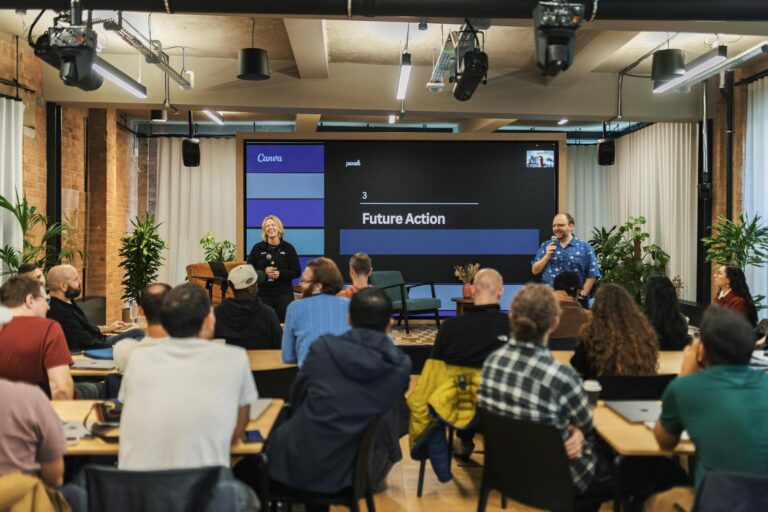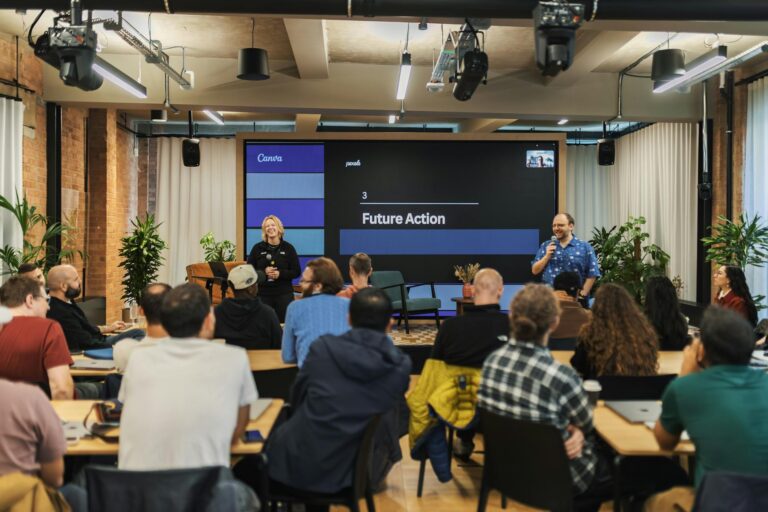Essential Digital Strategies for Business Growth in 2025
Mastering Tomorrow: Essential Digital Transformation Strategies for 2025 and Beyond
Estimated reading time: 10-12 minutes
Key Takeaways
- Prioritize website speed and modern web frameworks like Next.js for a performant online presence.
- Adopt cross-platform mobile development (e.g., Flutter, React Native) for efficiency, while recognizing the need for native expertise for specialized applications.
- Embrace cloud computing, serverless architectures, and DevOps (CI/CD) for scalability, cost-efficiency, and rapid software delivery.
- Integrate AI automation into products and workflows (e.g., chatbots, task automation) to boost efficiency and enhance customer service.
- Focus on user-centric and accessible UI/UX design to ensure delightful, intuitive, and inclusive digital experiences.
- Digital transformation is accessible for businesses of all sizes, achievable by starting small, leveraging cost-effective cloud tools, and automating repetitive tasks.
Table of Contents
- The Evolution of the Web: Speed, Agility, and Unmatched User Experience
- Mobile Innovation: Reaching Customers Everywhere with Seamless Experiences
- Cloud Computing & DevOps: Scaling with Efficiency and Resilience
- The AI Automation Revolution: Smartening Your Business Operations
- Modern UI/UX Design: Crafting Seamless and Inclusive Digital Experiences
- Digital Transformation on a Budget: Strategies for Small Companies
- Your Path to Digital Excellence with AI TechScope
The pace of technological innovation is accelerating at an unprecedented rate, reshaping every facet of the business landscape. From how we build websites to how we manage customer interactions, the future of work is being written today by cutting-edge advancements in web development, mobile applications, cloud computing, AI automation, and user experience design. For businesses looking to thrive, merely keeping up isn’t enough; proactively implementing robust digital transformation strategies is paramount for sustained growth, efficiency, and competitive advantage.
This comprehensive guide, informed by the latest industry insights and research, breaks down the key trends and actionable steps businesses must take to navigate the digital frontier. Whether you’re a business owner, manager, entrepreneur, or tech-forward professional, understanding these shifts and integrating them into your operations will be the bedrock of your success in 2025 and beyond.
The Evolution of the Web: Speed, Agility, and Unmatched User Experience
The web remains the primary interface for most businesses, and its evolution is driven by demands for speed, scalability, and richer user experiences. Modern web development is no longer just about having an online presence; it’s about delivering a blazing-fast, highly responsive, and intuitively designed digital storefront that converts.
Next-Gen Web Frameworks for Performance and Agility
For many businesses, especially small to medium-sized enterprises, a fast, engaging marketing site is crucial. Tools like Next.js have emerged as powerhouses for building performant web applications. As highlighted in “Next.js for Small Businesses: Build a Fast Marketing Site in One Weekend,” Next.js offers server-side rendering and static site generation, which significantly improve loading times and SEO. This translates directly into better user engagement and higher search engine rankings—a critical component of any effective digital transformation strategy.
Beyond initial build speed, ongoing performance is key. Our research points to “5 Simple React Performance Fixes That Reduce Page Load by Seconds,” demonstrating that even established React applications can achieve significant speed gains with targeted optimizations. These include memoization, lazy loading components, and optimizing image delivery. Such performance enhancements aren’t just technical niceties; they are fundamental to customer satisfaction and bounce rate reduction, directly impacting your bottom line.
Architectural Innovations: Micro Frontends for Scalability
As web applications grow in complexity, traditional monolithic frontends can become unwieldy. “Micro Frontends: When They Help and When They Hurt (Practical Examples)” introduces a modular approach where independent teams can develop and deploy separate parts of the user interface. This architecture promotes agility, reduces dependencies, and can significantly accelerate development cycles for large, feature-rich applications. While not suitable for every project, understanding micro frontends is vital for businesses anticipating significant future growth and requiring flexible team structures.
Optimizing Existing Platforms: WordPress Without the Bloat
For the millions of businesses relying on WordPress, performance and SEO are often a concern. “WordPress Without the Bloat: Lightweight Plugins That Actually Help SEO” provides valuable insights into how to strip away unnecessary elements and focus on plugins that genuinely contribute to site speed and search visibility. This proactive optimization of existing assets is a pragmatic digital transformation strategy for many.
Actionable Takeaway:
Prioritize website speed, adopt modern frameworks like Next.js for new projects, and continuously optimize existing platforms. A fast, agile, and performant web presence is a non-negotiable asset in today’s digital economy.
Mobile Innovation: Reaching Customers Everywhere with Seamless Experiences
The smartphone is the primary device for digital interaction for billions worldwide. For businesses, a robust mobile strategy isn’t optional; it’s a cornerstone of customer engagement and market reach. The decision of how to build mobile applications, however, is becoming increasingly nuanced.
Cross-Platform Dominance: Flutter vs. React Native in 2025
The debate between native and cross-platform mobile development continues, but cross-platform frameworks like Flutter and React Native are increasingly favored for their efficiency and ability to target both iOS and Android from a single codebase. “React Native vs Flutter in 2025: Which Is Best for Your Business App?” delves into the strengths of each, highlighting Flutter’s strong performance and beautiful UI capabilities, contrasted with React Native’s mature ecosystem and JavaScript familiarity. For businesses aiming for rapid deployment and cost-effectiveness, these frameworks offer compelling solutions for delivering high-quality mobile experiences.
Flutter, in particular, empowers businesses to “Build a Simple Cross-Platform App with Flutter: From Idea to Play Store,” demonstrating its capacity for quick prototyping and full-scale application development. This agility is invaluable for startups and established businesses alike seeking to expand their mobile footprint without duplicating development efforts.
The Enduring Importance of Native Expertise
While cross-platform solutions are powerful, specific business needs may still warrant native development. The summary from @YesITLabs, “Android Application Development Company | Android Apps Development Services,” reminds us of the continued demand for specialized native expertise, particularly for applications requiring deep OS integration, maximum performance, or unique hardware features. Understanding when to choose native versus cross-platform is a critical decision in shaping your mobile digital transformation strategy.
Actionable Takeaway:
Invest in a performant and strategically chosen mobile application development approach. Leverage cross-platform frameworks for broad reach and efficiency, but be prepared to engage native expertise for highly specialized requirements.
Cloud Computing & DevOps: Scaling with Efficiency and Resilience
The cloud has fundamentally altered how businesses manage infrastructure, data, and applications. Coupled with DevOps practices, it offers unprecedented agility, scalability, and cost-efficiency—key drivers for any successful digital transformation.
Seamless Cloud Migration for Legacy Systems
For many established businesses, the challenge isn’t just adopting the cloud, but migrating existing legacy applications without disruption. “How to Move Your Legacy App to the Cloud Without Breaking It” provides crucial insights into phased migration strategies, emphasizing careful planning, thorough testing, and leveraging cloud-native services to re-platform or refactor applications. This pragmatic approach minimizes risk and maximizes the benefits of cloud infrastructure.
Serverless Architecture: The Epitome of Cost-Efficiency and Scale
Serverless computing, exemplified by solutions like AWS Lambda, represents a paradigm shift in backend development. “Serverless on AWS: Create a Cost-Efficient Backend That Scales Automatically” explains how businesses can build and deploy applications without managing servers, paying only for the compute resources consumed. This model drastically reduces operational overhead, enhances scalability to handle fluctuating loads, and frees up development teams to focus on core business logic—a transformative approach for businesses seeking lean and efficient operations.
DevOps Best Practices: CI/CD for Small Teams
DevOps, a set of practices that combines software development and IT operations, is essential for accelerating delivery and improving software quality. “CI/CD for Small Teams: Automated Deployments Without the Headache” illustrates how even smaller teams can implement Continuous Integration and Continuous Deployment (CI/CD) pipelines using tools like GitHub Actions. Automating the build, test, and deployment process reduces manual errors, speeds up release cycles, and ensures a consistent, reliable software delivery pipeline. This agility is indispensable for businesses needing to adapt quickly to market demands.
Actionable Takeaway:
Embrace cloud infrastructure for scalability and cost optimization. Implement DevOps practices, including CI/CD and serverless architectures, to enhance agility, reduce operational burdens, and accelerate product delivery.
The AI Automation Revolution: Smartening Your Business Operations
Artificial Intelligence (AI) is no longer a futuristic concept; it’s a practical tool enabling businesses to achieve unprecedented levels of efficiency, personalization, and insight. Integrating AI automation into daily workflows is rapidly becoming a cornerstone of successful digital transformation strategies.
Infusing AI into Products and Workflows
Even seemingly small AI features can have a profound impact. “Make Your SaaS Smarter: 3 Low-Effort AI Features That Delight Users” suggests practical ways to integrate AI, such as intelligent search, personalized recommendations, or automated content generation, to enhance user experience and product value without massive investment.
For day-to-day operations, the impact is even more immediate. “Automate Repetitive Tasks with No-Code Tools + AI (Save 5–10 Hours/Week)” reveals how businesses can leverage AI-powered no-code platforms to automate mundane, time-consuming tasks. Imagine automatically categorizing emails, generating reports, or orchestrating complex data flows – freeing up valuable human capital for strategic work. This isn’t just about saving time; it’s about reallocating human ingenuity to higher-value activities.
Chatbots: Revolutionizing Customer Service and Internal Efficiency
One of the most accessible and impactful applications of AI for businesses is chatbot technology. “How Small Businesses Use Chatbots to Save Time: Real Workflows That Work” showcases how chatbots can handle routine customer inquiries, qualify leads, and even assist internal teams by answering FAQs. This not only improves customer service availability and response times but also significantly reduces the workload on human staff, allowing them to focus on more complex, empathetic interactions.
AI TechScope’s Role in Your Automation Journey:
This is where AI TechScope shines. We specialize in helping businesses leverage these cutting-edge AI tools and technologies to scale operations, reduce costs, and improve efficiency. Our expertise in AI automation means we identify key areas where intelligent delegation can transform your workflows. Through n8n workflow automation, we build bespoke, interconnected systems that streamline everything from data processing to customer engagement. We help you connect the dots between AI trends and tangible business benefits like business efficiency, workflow optimization, and ultimately, a powerful competitive advantage.
Actionable Takeaway:
Actively seek opportunities to integrate AI automation into your products and internal processes. Start with repetitive tasks and customer service to realize immediate benefits in efficiency and cost reduction.
Modern UI/UX Design: Crafting Seamless and Inclusive Digital Experiences
Technology’s power is only as effective as its usability. Modern User Interface (UI) and User Experience (UX) design are critical components of any successful digital product, ensuring that technology is not just functional but also delightful, intuitive, and accessible.
Design for Delight and Accessibility
An engaging UI combined with a seamless UX differentiates products in a crowded market. It reduces frustration, increases adoption, and fosters brand loyalty. But great design goes beyond aesthetics; it must be inclusive. “Designing Accessible Buttons: A Non-Designer’s Guide (Figma Tips)” emphasizes the importance of accessibility in design—ensuring that digital products are usable by people with diverse abilities. This includes considerations like contrast ratios, clear labeling, and keyboard navigability. An accessible design is not just a regulatory compliance; it’s a moral imperative and a smart business decision that broadens your market reach.
The Strategic Imperative of User-Centric Design
In a competitive landscape, user experience often dictates success. A poorly designed app, website, or digital tool can drive users away, regardless of how robust its underlying technology is. Investing in modern UI/UX design is therefore an investment in your customer base, leading to higher engagement, better conversions, and ultimately, stronger digital transformation strategies.
Actionable Takeaway:
Prioritize user-centric and accessible design in all your digital products. A seamless, intuitive, and inclusive user experience is a powerful driver of customer satisfaction and business growth.
Digital Transformation on a Budget: Strategies for Small Companies
Many businesses, especially small and medium-sized enterprises, might feel overwhelmed by the scope of digital transformation. However, it doesn’t require an astronomical budget to start. “Digital Transformation on a Budget: 7 Steps Small Companies Can Start Today” offers a pragmatic roadmap.
Key steps include:
- Start Small, Think Big: Identify one or two high-impact areas for transformation.
- Leverage Cloud-Native Services: Utilize scalable, pay-as-you-go cloud solutions (like serverless).
- Embrace No-Code/Low-Code Tools: Empower non-developers to build solutions rapidly.
- Automate Repetitive Tasks: Free up staff for more strategic work.
- Focus on Data Insights: Use analytics to make informed decisions.
- Prioritize Customer Experience: Make every digital touchpoint seamless.
- Seek Expert Guidance: Partner with specialists who can provide targeted solutions.
For instance, a small business can leverage Next.js for a fast marketing site in a weekend, implement CI/CD with GitHub Actions for smoother deployments, and integrate AI-powered chatbots to manage customer inquiries—all without massive upfront investments. These incremental changes, guided by a clear vision, accumulate into significant digital transformation strategies.
Actionable Takeaway:
Digital transformation is accessible to all businesses. Start with small, impactful projects, leverage cost-effective cloud and automation tools, and continuously iterate based on results.
Your Path to Digital Excellence with AI TechScope
The technologies of 2025 present an unparalleled opportunity for businesses to innovate, optimize, and grow. From accelerating web performance and expanding mobile reach to harnessing the power of the cloud and integrating intelligent automation, the future is now. Embracing these trends is not just about adopting new tools; it’s about a fundamental shift in your approach to business, driving business efficiency, achieving profound digital transformation, securing a robust competitive advantage, and optimizing every aspect of your workflow.
At AI TechScope, we empower businesses to navigate this complex landscape. Our expertise in AI automation, n8n workflow automation, AI consulting, and custom website development ensures you don’t just keep up with the future, but actively shape it. We provide the strategies and solutions to leverage these powerful technologies, turning challenges into opportunities and visions into reality.
Ready to transform your business and unlock new levels of efficiency and growth?
Explore AI TechScope’s AI automation and consulting services today. Let us help you integrate the latest technologies and implement winning digital transformation strategies that will define your success in the years to come.
FAQ Section
What are the essential digital transformation strategies for 2025?
Key strategies include prioritizing web speed with modern frameworks like Next.js, adopting cross-platform mobile development (Flutter/React Native), embracing cloud computing and DevOps, integrating AI automation for efficiency, and focusing on user-centric and accessible UI/UX design.
Why is website speed important for digital transformation?
Website speed is crucial because it directly impacts user engagement, reduces bounce rates, and significantly improves SEO rankings. A fast, responsive website provides a better user experience and contributes to higher conversion rates, making it a non-negotiable asset in today’s digital economy.
Should my business choose Flutter or React Native for mobile app development?
Both Flutter and React Native are excellent cross-platform frameworks for efficiency. Flutter offers strong performance and beautiful UI, while React Native has a mature ecosystem and JavaScript familiarity. The best choice depends on your specific business needs, existing tech stack, and desired development speed.
How can small businesses implement digital transformation on a budget?
Small businesses can start by identifying high-impact areas, leveraging cost-effective cloud-native services (like serverless), embracing no-code/low-code tools, automating repetitive tasks with AI, focusing on data insights, prioritizing customer experience, and seeking expert guidance for targeted solutions.
What role does AI automation play in business efficiency?
AI automation revolutionizes business efficiency by automating repetitive tasks, enhancing customer service through chatbots, providing personalized user experiences, and generating valuable insights from data. This frees up human capital for strategic work, reduces operational overhead, and drives overall workflow optimization.







